Lalanne C. Mechanical Vibrations and Shocks: Mechanical Shock Volume II
Подождите немного. Документ загружается.

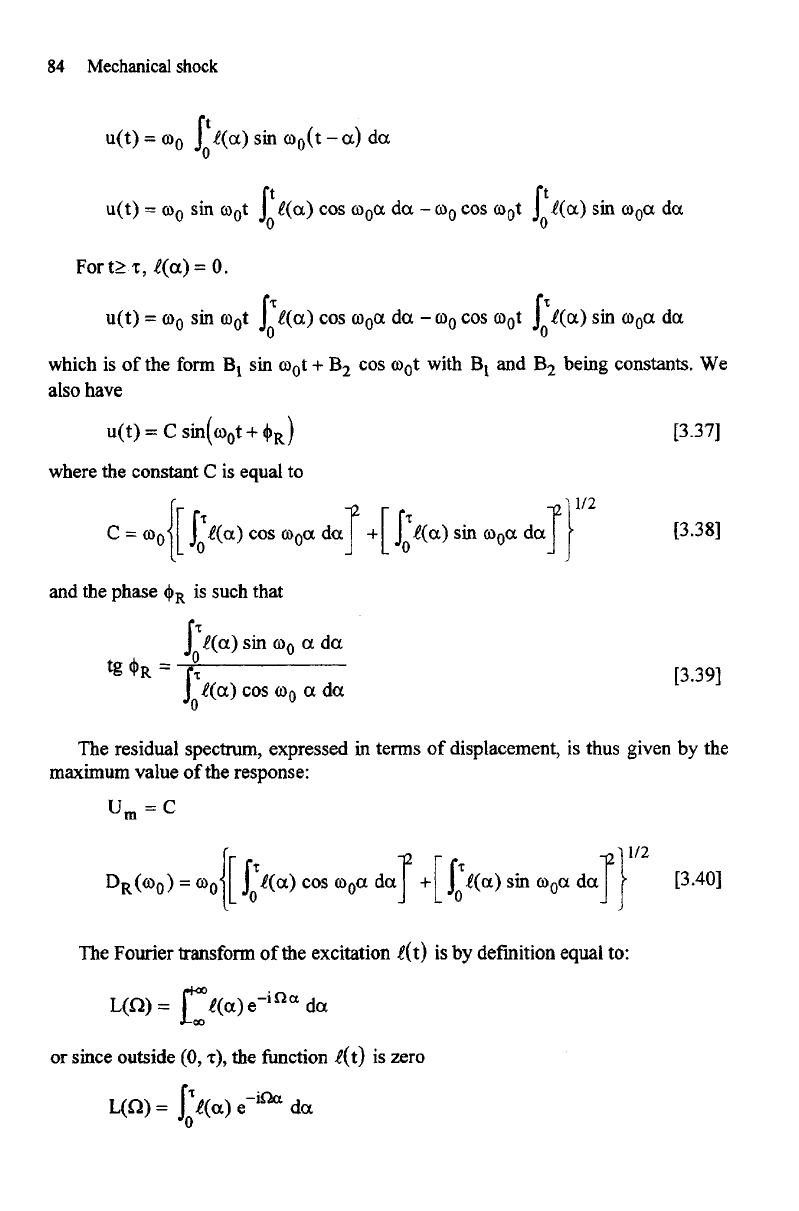
84
Mechanical
shock
which
is of the
form
B1 sin
co
0
t
+ B
2
cos
<o
0
t
with
B1 and B
2
being
constants.
We
also have
where
the
constant
C is
equal
to
and the
phase
<f>
R
is
such that
The
residual spectrum, expressed
in
terms
of
displacement,
is
thus given
by the
maximum
value
of the
response:
The
Fourier transform
of the
excitation l(i)
is by
definition equal
to:
or
since outside
(0, T), the
function t(t)
is
zero
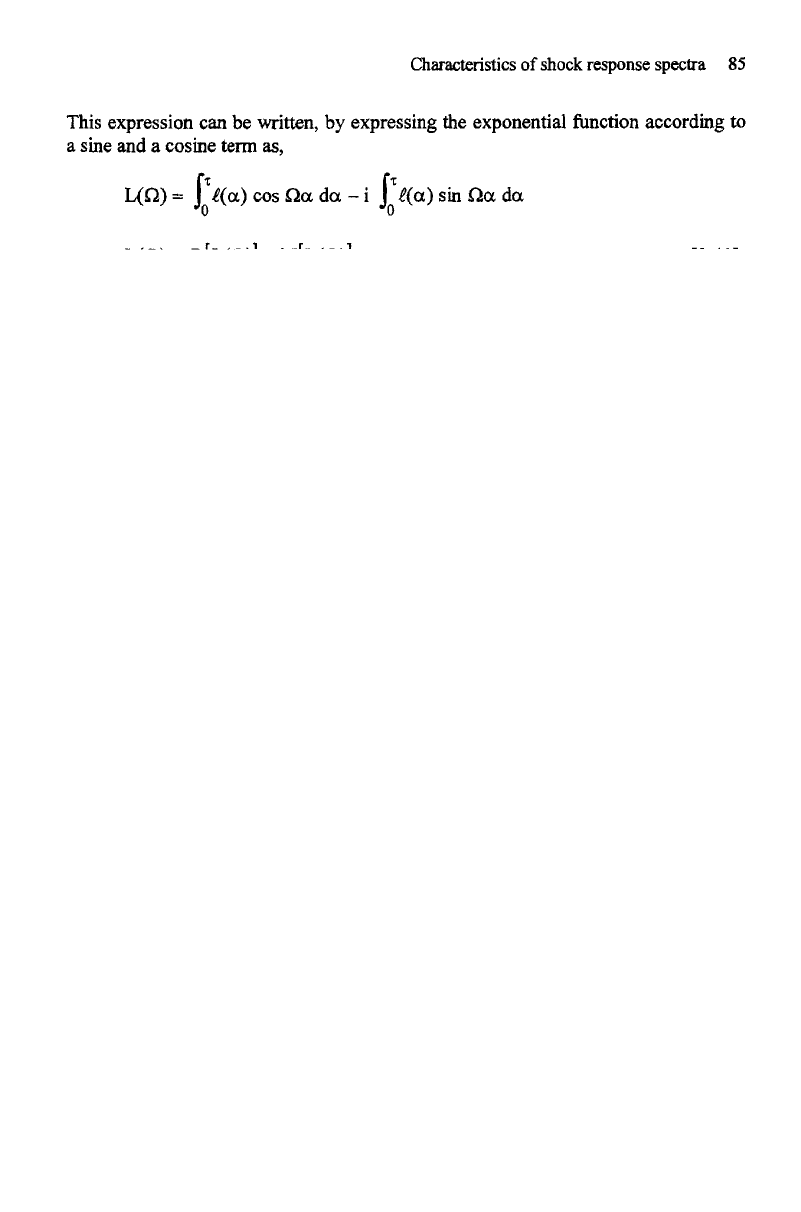
71 71
Only
the
values
of
<j>
L
€
(-—,+
—)
will
be
considered. Comparison
of
<j)
R
and
(|>
L
2 2
show
that
This expression
can be
written,
by
expressing
the
exponential function according
to
a
sine
and a
cosine term
as,
where R(n)
is the
real part
of the
Fourier integral
and
I(Q)
the
imaginary part.
L(Q)
is a
complex quantity whose module
is
given
by
Let
us
compare
the
expressions
of
D
R
(Q)
and of
|L(Q)|.
Apart
from the
factor
w
0
and
provided that
one
changes
O
0
into
Q,
these
two
quantities
are
identical.
The
natural
frequency of the
system
o>
0
can
take
an
arbitrary value
since
the
simple
mechanical system
is not yet
chosen, equal
in
particular
to Q. We
thus obtain
the
relation
The
phase
is
given
by
For
an
undamped system,
the
Fourier spectrum
and the
residual positive shock
spectrum
are
related
in
amplitude
and
phase
[CA V
64].
NOTE:
If
the
excitation
is an
acceleration,
and
if,
in
addition,
the
Fourier
transform
of x
(t),
we
have [GER 66],
[NAS
65]:
Characteristics
of
shock
response
spectra
85
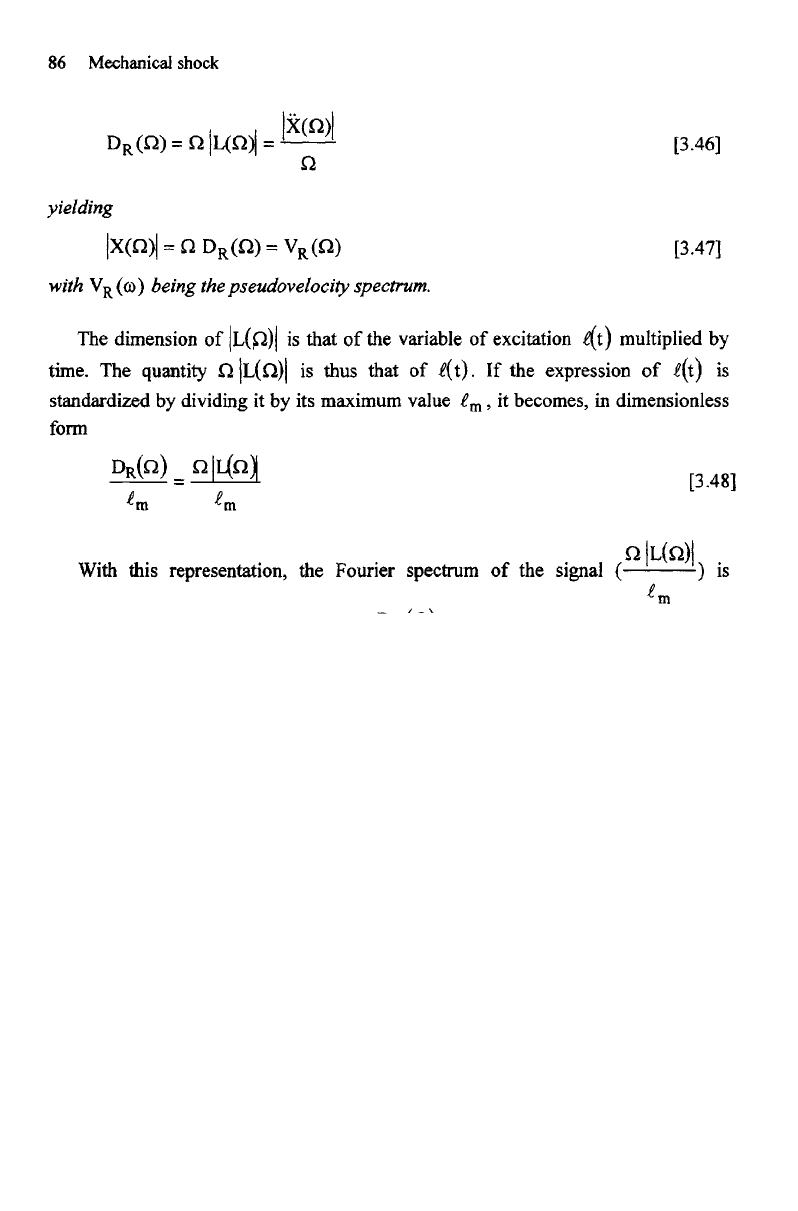
86
Mechanical shock
3.8.3.
Comparison
of
the
relative severity
of
several shocks using their Fourier
spectra
and
their shock response spectra
Let
us
consider
the
Fourier
spectra
(amplitude)
of two
shocks,
one
being
an
isosceles triangle shape
and the
other
TPS
(Figure
3.19),
like their positive shock
response
spectra,
for
zero
damping (Figure
3.20).
yielding
with
V
R
(oo)
being
the
pseudovelocity spectrum.
The
dimension
of
|L(p)|
is
that
of the
variable
of
excitation
^t)
multiplied
by
time.
The
quantity
Q
|L(Q)|
is
thus that
of
l(i).
If the
expression
of
l{t)
is
standardized
by
dividing
it by its
maximum value
l
m
, it
becomes,
in
dimensionless
form
With
this representation,
the
Fourier spectrum
of the
signal
identical
to its
residual shock spectrum
for
zero
damping [SUT 68].
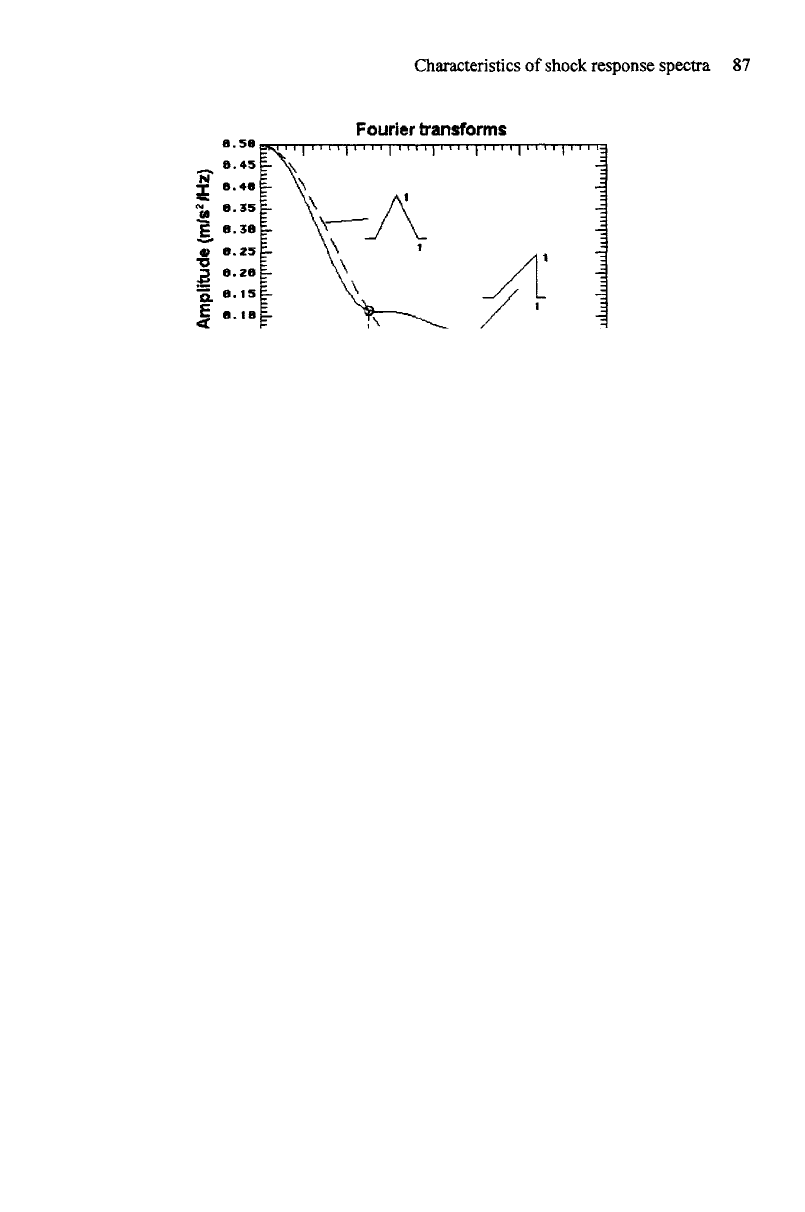
Characteristics
of
shock
response
spectra
87
Figure 3.20.
Comparison
of
the
positive
SRS
of
a
TPS
pulse
and
an
isosceles triangle pulse
It
is
noted that
the
Fourier
spectra
and
shock
response
spectra
of the two
impulses
have
the
same relative position
as
long
as the frequency
remains lower than
f
=1.25
Hz, the
range
for
which
the
shock response spectrum
is
none other than
the
residual spectrum, directly related
to the
Fourier spectrum.
On
the
contrary,
for f >
1.25
Hz, the TPS
pulse
has a
larger Fourier spectrum,
whereas
the SRS
(primary spectrum)
of the
isosceles triangle pulse
is
always
in the
form
of the
envelope.
Figure
3.19.
Comparison
of
the
Fourier
transform
amplitudes
of
a
TPS
pulse
and
an
isosceles triangle pulse
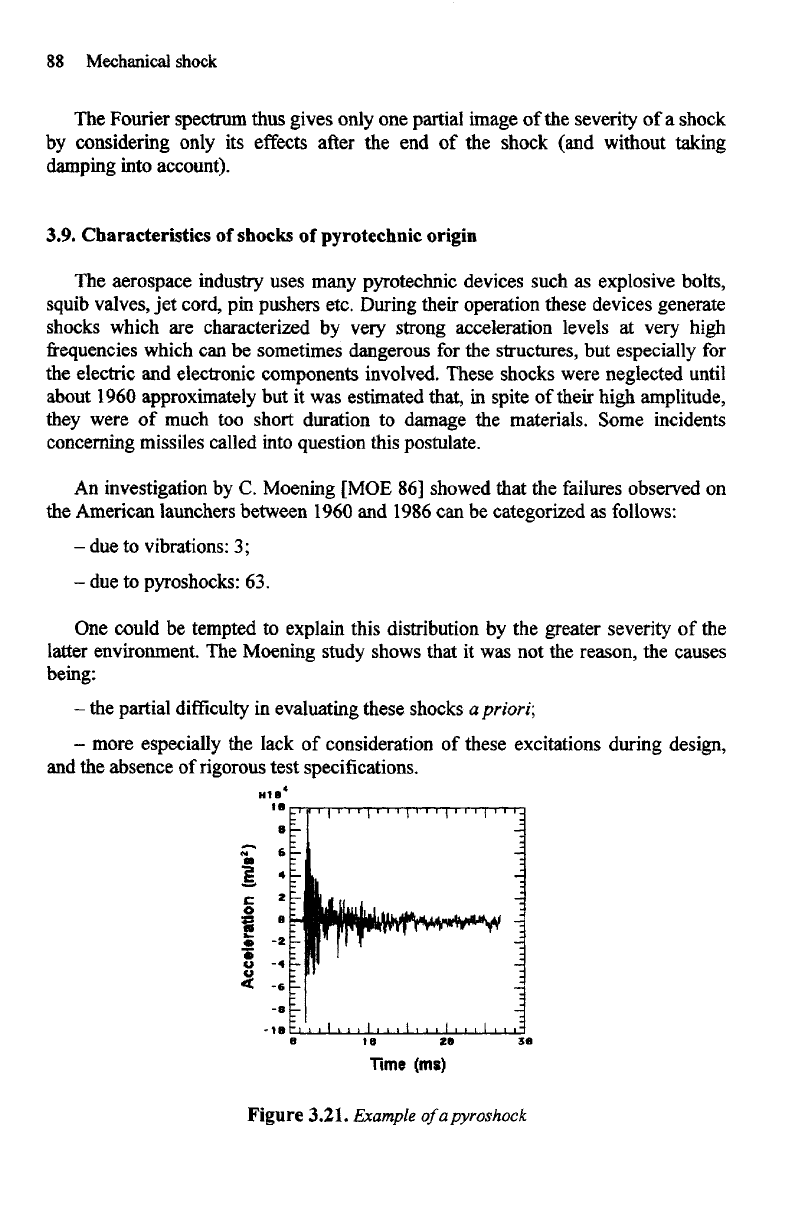
88
Mechanical shock
The
Fourier spectrum thus gives only
one
partial image
of the
severity
of a
shock
by
considering
only
its
effects
after
the end of the
shock (and without taking
damping
into account).
3.9. Characteristics
of
shocks
of
pyrotechnic origin
The
aerospace industry uses many pyrotechnic devices such
as
explosive bolts,
squib valves,
jet
cord,
pin
pushers etc. During their operation these devices generate
shocks which
are
characterized
by
very strong
acceleration
levels
at
very high
frequencies
which
can be
sometimes dangerous
for the
structures,
but
especially
for
the
electric
and
electronic
components
involved. These shocks were neglected until
about 1960 approximately
but it was
estimated that,
in
spite
of
their high amplitude,
they
were
of
much
too
short duration
to
damage
the
materials. Some incidents
concerning missiles called
into
question
this
postulate.
An
investigation
by C.
Moening [MOE
86]
showed that
the
failures
observed
on
the
American launchers between 1960
and
1986
can be
categorized
as
follows:
-
due
to
vibrations:
3;
-
due
to
pyroshocks:
63.
One
could
be
tempted
to
explain this distribution
by the
greater severity
of the
latter
environment.
The
Moening study shows that
it was not the
reason,
the
causes
being:
- the
partial
difficulty
in
evaluating these shocks
a
priori;
-
more especially
the
lack
of
consideration
of
these excitations during design,
and
the
absence
of
rigorous
test
specifications.
Figure
3.21.
Example
ofapyroshock
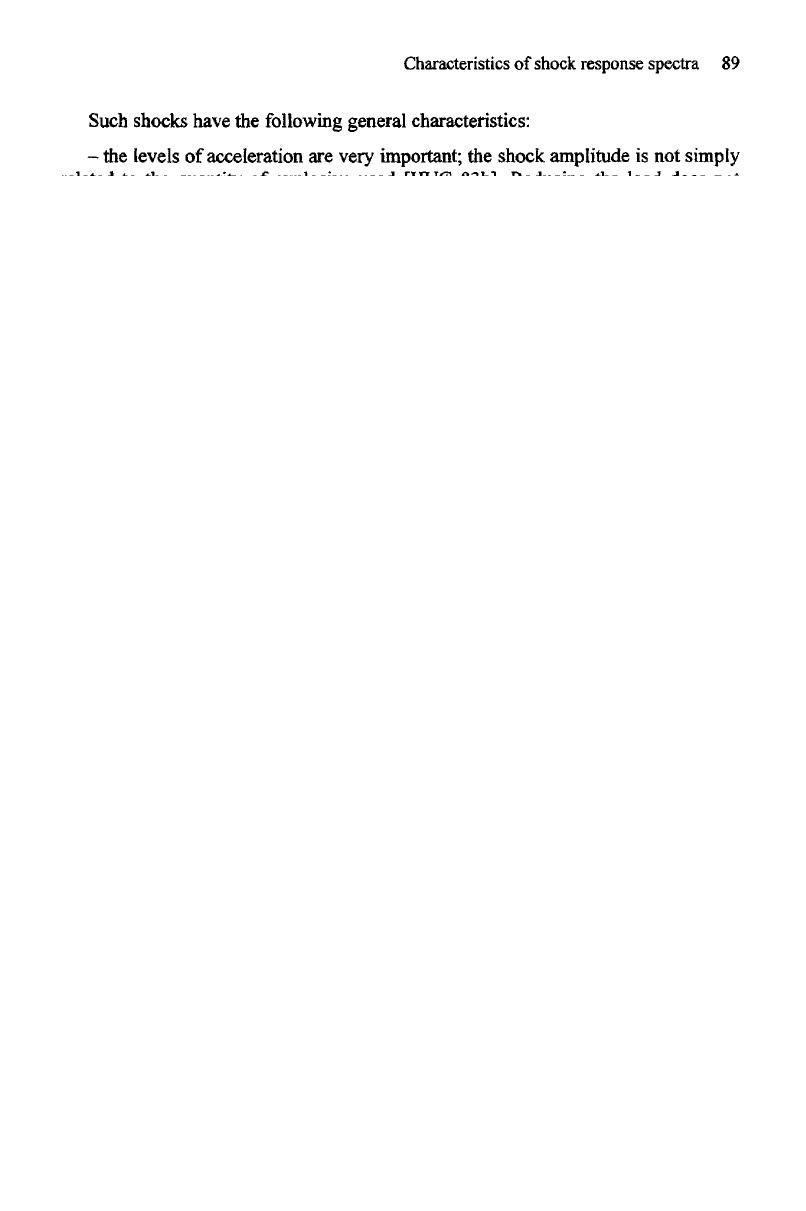
Characteristics
of
shock response spectra
89
Such
shocks have
the
following general characteristics:
- the
levels
of
acceleration
are
very important;
the
shock amplitude
is not
simply
related
to the
quantity
of
explosive used [HUG 83b]. Reducing
the
load does
not
reduce
the
consequent shock.
The
quantity
of
metal
cut by a jet
cord
is, for
example,
a
more significant factor;
- the
signals assume
an
oscillatory shape;
- in the
near-field, close
to the
source (material within about
15 cm of
point
of
detonation
of the
device,
or
about
7 cm for
less intense pyrotechnic devices),
the
effects
of the
shocks
are
primarily related
to the
propagation
of a
stress wave
in the
material;
- the
shock
is
then propagated
whilst
attenuating
in the
structure.
The
mid-field
(material within about
15 cm and 60 cm for
intense pyrotechnic devices, between
3 cm and 15 cm for
less intense
devices)
from,
which
the
effects
of
this wave
are not
yet
negligible
and
combine with
a
damped oscillatory response
of the
structure
at its
frequencies of
resonance,
is to be
distinguished
from the
far-field,
where only this
last
effect
persists;
- the
shocks have very close components according
to
three axes; their positive
and
negative
response
spectra
are
curves that
are
coarsely symmetrical with
respect
to the
axis
of the frequencies.
They begin
at
zero
frequency
with
a
very small slope
at
the
origin, grow with
the frequency
until
a
maximum located
at
some kHz, even
a
few
tens
of
kHz,
is
reached
and
then tend according
to the
rule towards
the
amplitude
of the
temporal signal.
Due to
their
contents
at
high
frequencies,
such
shocks
can
damage
electric
or
electronic
components;
- the a
priori estimate
of
the
shock levels
is
neither easy
nor
precise.
These
characteristics make them
difficult
to
measure, requiring sensors that
are
able
to
accept
amplitudes
of
100,000
g, frequencies
being able
to
exceed
100
kHz,
with
important transverse components. They
are
also
difficult
to
simulate.
The
dispersions observed
in the
response spectra
of
shocks measured under
comparable
conditions
are
often
important
(3 dB
with more than
8 dB
compared
to
the
average value, according
to the
authors [SMI
84]
[SMI 86]),
The
reasons
for
this
dispersion
are in
general related
to
inadequate instrumentation
and the
conditions
of
measurement
[SMI 86]:
- fixing the
sensors
on the
structure using insulated studs
or
wedge which
act
like
mechanical
filters;
-
zero
shift,
due to the
fact that high accelerations make
the
crystal
of the
accelerometer work
in a
temporarily non-linear
field.
This
shift
can
affect
the
calculation
of the
shock response spectrum (cf. Section 3.10.2.);
-
saturation
of
the
amplifiers;
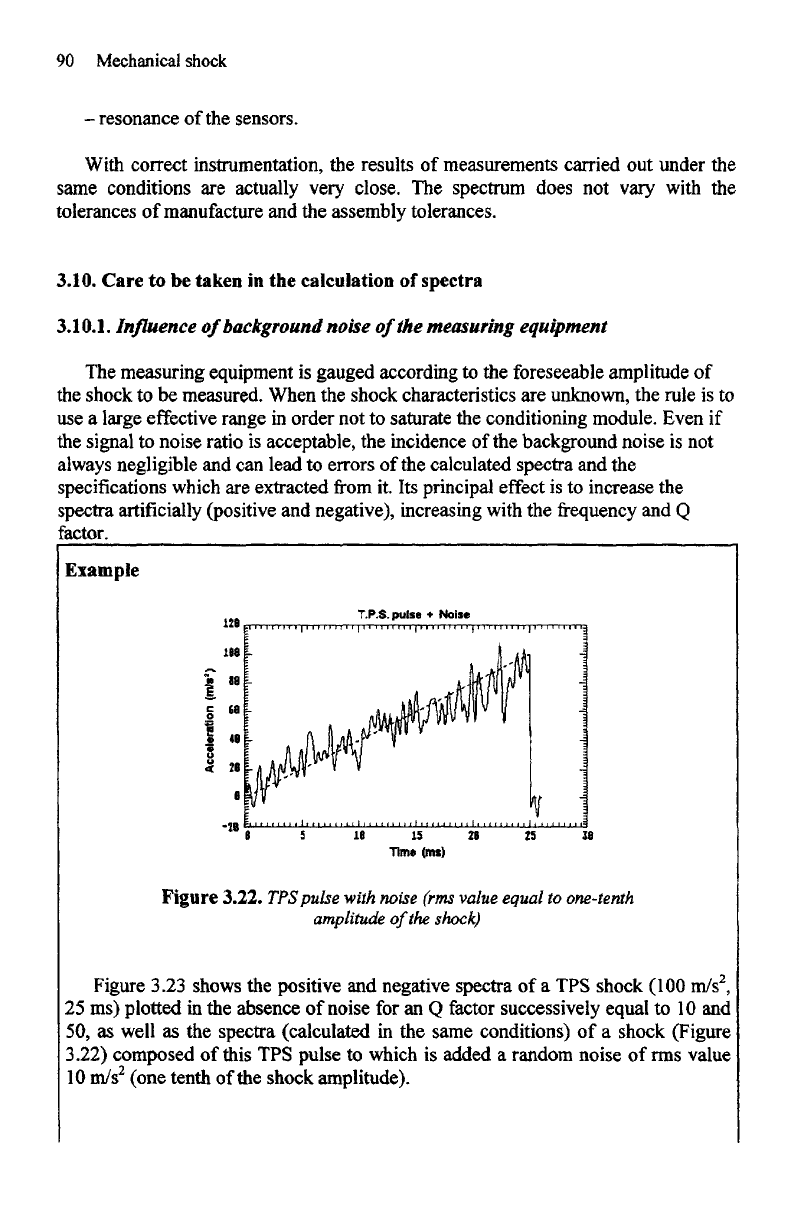
90
Mechanical shock
-
resonance
of
the
sensors.
With
correct instrumentation,
the
results
of
measurements carried
out
under
the
same
conditions
are
actually very close.
The
spectrum does
not
vary
with
the
tolerances
of
manufacture
and the
assembly tolerances.
3.10.
Care
to be
taken
in the
calculation
of
spectra
3.10.1.
Influence
of
background
noise
of
the
measuring
equipment
The
measuring equipment
is
gauged according
to the
foreseeable amplitude
of
the
shock
to be
measured. When
the
shock characteristics
are
unknown,
the
rule
is to
use a
large effective range
in
order
not to
saturate
the
conditioning module. Even
if
the
signal
to
noise ratio
is
acceptable,
the
incidence
of the
background noise
is not
always
negligible
and can
lead
to
errors
of the
calculated spectra
and the
specifications
which
are
extracted
from it. Its
principal
effect
is to
increase
the
spectra artificially (positive
and
negative), increasing with
the frequency and Q
factor.
Example
Figure
3.22.
TPSpulse
with noise (rms value equal
to
one-tenth
amplitude
of
the
shock)
Figure
3.23 shows
the
positive
and
negative
spectra
of a TPS
shock (100 m/s
2
,
25 ms)
plotted
in the
absence
of
noise
for an Q
factor
successively equal
to 10 and
50,
as
well
as the
spectra
(calculated
in the
same conditions)
of a
shock (Figure
3.22) composed
of mis TPS
pulse
to
which
is
added
a
random noise
of rms
value
10
m/s
2
(one tenth
of the
shock amplitude).

Characteristics
of
shock response spectra
91
Due
to its
random nature,
it is
practically impossible
to
remove
the
noise
of the
measured
signal
to
extract
the
shock alone
from it.
Techniques, however have been
developed
to try to
correct
the
signal
by
cutting
off the
Fourier transform
of the
noise
from
that
of the
total signal (subtraction
of the
modules, conservation
of the
phase
of the
total
signal) [CAI 94].
Figure
3.23. Positive
and
negative
SRS
of
the
TPS
pulse
and
with noise
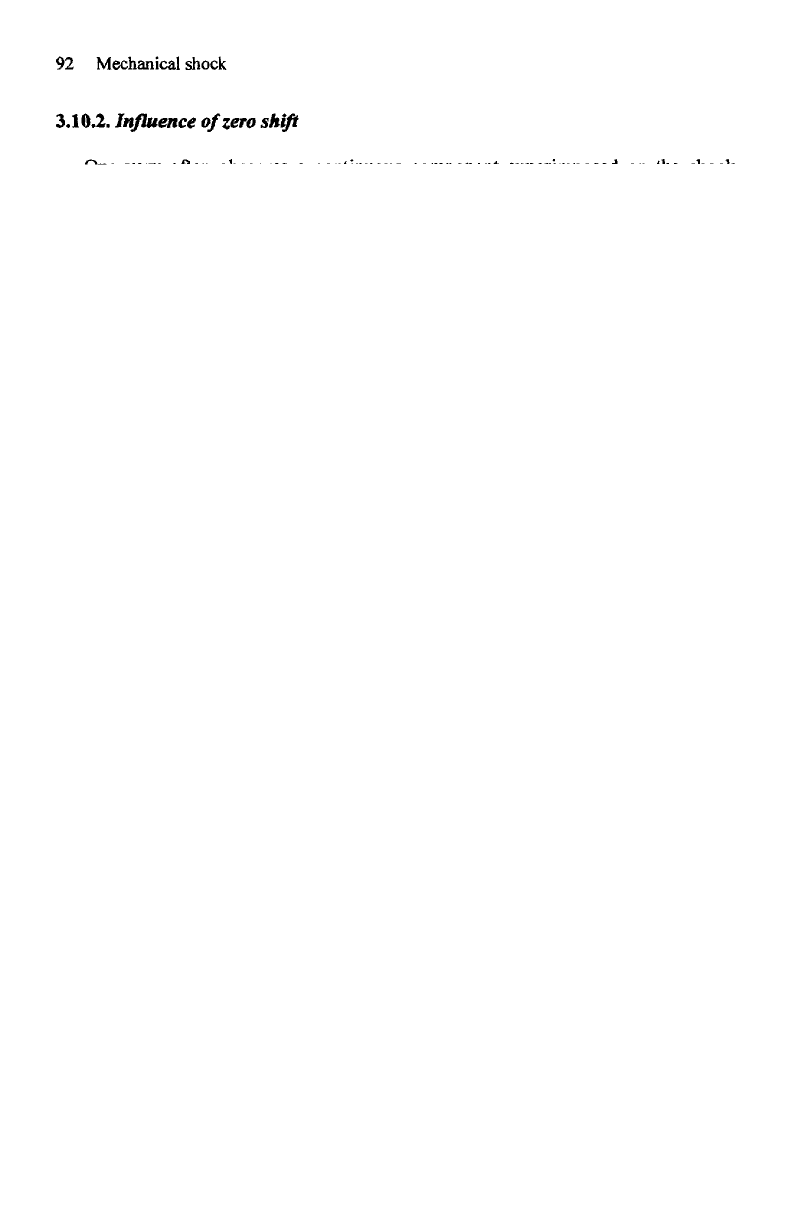
92
Mechanical shock
3.10.2.
Influence
of
zero
shift
One
very
often
observes
a
continuous component superimposed
on the
shock
signal
on the
recordings,
the
most
frequent
origin being
the
presence
of a
transverse
high
level component which disturbs
the
operation
of the
sensor.
If
this component
is
not
removed
from the
signal before calculation
of the
spectra,
it can it
also lead
to
considerable errors [BAG
89]
[BEL 88].
When
this continuous component
has
constant amplitude,
the
signal treated
is in
fact
a
rectangle modulated
by the
true signal.
It is not
thus surprising
to find on the
spectrum
of
this composite signal
the
characteristics, more
or
less marked,
of the
spectra
of a
rectangular shock.
The
effect
is
particularly
important
for
oscillatory
type shocks (with zero
or
very small velocity change) such
as, for
example, shocks
of
pyrotechnic origin.
In
this last case,
the
direct component
has as a
consequence
a
modification
of the
spectrum
at low frequencies
which results
in
[LAL 92a]:
- the
disappearance
of the
quasi-symmetry
of the
positive
and
negative spectra
characteristic
of
this type
of
shocks;
-
appearance
of
more
or
less clear lobes
in the
negative spectrum, similar
to
those
of a
pure rectangular shock.
Example
Figure 3.24. 24.
pyrotechnic shock with zero shift
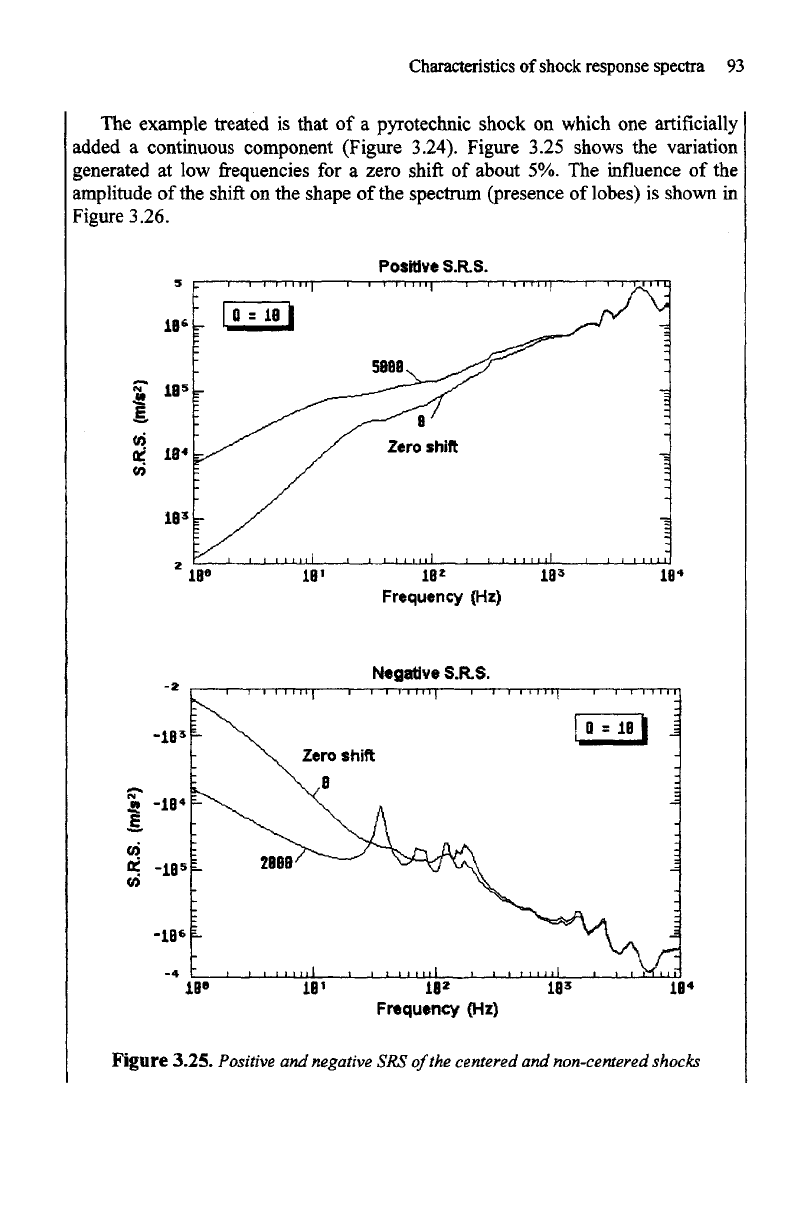
Characteristics
of
shock response
spectra
93
The
example treated
is
that
of a
pyrotechnic shock
on
which
one
artificially
added
a
continuous component (Figure
3.24).
Figure 3.25 shows
the
variation
generated
at low frequencies for a
zero
shift
of
about
5%. The
influence
of the
amplitude
of the
shift
on the
shape
of the
spectrum (presence
of
lobes)
is
shown
in
Figure
3.26.
Figure 3.25.
Positive
and
negative
SRS
of
the
centered
and
non-centered shocks
